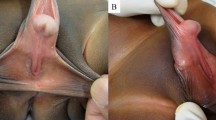Summary
Between 1977 and 1996 we treated 176 patients suffering from complicated urethral strictures with the mesh-graft urethroplasty. This operation technique has replaced the Bengt-Johanson-Operation which had been used frequently until that date. The Cecil-Operation has been totally abandoned, because in our opinion the usage of scrotal skin in urethral reconstruction is obsolete today. The mesh-graft technique is based on the free transfer of meshed prepuce (full-thickness skin or split-thickness skin) in a two stage procedure. In 37 patients the inner layer of the prepuce was used, in 63 patients we only used split-thickness skin grafts and in 76 patients we applied a combination of both, the inner layer of the prepuce in addition to a split-thickness skin graft. After complete healing of the graft (first stage) the formation of the neourethra follows as the second stage procedure. The mesh graft procedure can be used to treat all kinds of strictures independant of the etiology or localisation. Hair growth, diverticula development and stone formation that are observed frequently as complications with scrotal skin substitutes can be avoided. Due to these advantages encouraging long term results could be obtained with the mesh graft urethroplasty. In 162 patients (92 %) with a minimum follow-up of 7 years we achieved a successful result of the operations, a significant improvement could be obtained in 7 patients (4 %). Unfortunately in further 7 cases (4 %) the operation method ultimately failed. In particular in patients with complicated and severe strictures after numerous unsuccessfull prior reconstructive attempts, extensive long strictures and strictures in paraplegic patients, mesh graft urethroplasty has been shown to be a safe and reliable treatment option.
Zusammenfassung
Von 1977 bis 1996 wurden 176 Patienten mit komplizierter Harnröhrenstriktur durch die Meshgraft-Urethroplastik behandelt. Diese Operationsmethode hat das bis dahin gängige zweizeitige Verfahren der Bengt-Johanson-Operation bzw. der Operation nach Cecil vollständig verdrängt, da nach unserer Ansicht die Verwendung von Skrotalhaut zur Rekonstruktion der Harnröhre heute als obsolet angesehen werden muß. Die Operation basiert auf der freien Transplantation von genetzter Vorhaut (Vollhaut oder dünnen Spalthauttransplantaten) in einem zweizeitigen Verfahren. Bei 37 Patienten wurde das innere Blatt der Vorhaut, bei 63 Patienten ausschließlich Spalthaut und bei 76 Patienten die Kombination aus innerem Vorhautblatt und Spalthaut angewandt. Nach Einheilung des Transplantates (erste Sitzung) erfolgt die Bildung der Neourethra (zweite Sitzung). Die Methode hat den Vorteil, daß sie praktisch für alle Verfahren der Harnröhrenrekonstruktion (Lokalisation und Ätiologie) geeignet ist und Haarwachstumsdivertikelbildung und Steinbildung in der Harnröhre, wie als Spätfolge nach Verwendung von Skrotalhaut oft beobachtet, nicht auftritt. Dadurch konnten hervorragende Langzeitergebnisse mit diesem Behandlungsverfahren erzielt werden. Bei 162 Patienten (92 %) war die Operation über einen Zeitraum von mehr als 7 Jahren erfolgreich, 7 Patienten (4 %) waren gebessert, und bei ebenfalls 7 Patienten (4 %) war die Methode nicht erfolgreich. Besonders bewährt hat sich das Verfahren der Meshgraft-Urethroplastik bei komplizierten Strikuren, z. B. nach multiplen Voroperationen, überlangen Strikturen und Strikturen bei querschnittgelähmten Patienten.
Similar content being viewed by others
Author information
Authors and Affiliations
Rights and permissions
About this article
Cite this article
Schreiter, F. Two stage urethroplasty. Urologe 37, 42–50 (1998). https://doi.org/10.1007/s001200050147
Published:
Issue Date:
DOI: https://doi.org/10.1007/s001200050147




